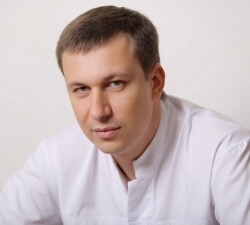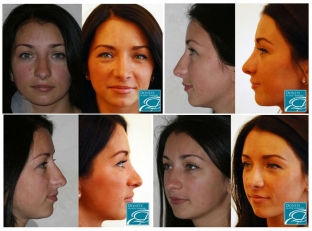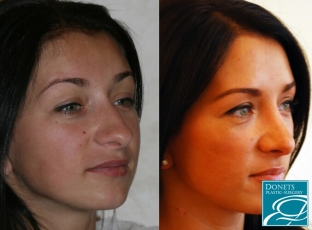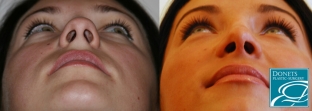Nose reshaping is one of the most requested plastic surgeries. Experts explain this by the fact that the nose – the most noticeable part of the face that attracts the attention of others, and therefore the imperfection of its shape can significantly worsen a person’s self-esteem and even affect the quality of his life.
 About how to correct the shape of the nose, what a patient who decides to undergo rhinoplasty needs to know, readers of estet-portal.com told Evgeny Georgievich Donets – plastic surgeon of the Medical Club clinic, full member of the International Society for Aesthetic Plastic Surgery ISAPS.
About how to correct the shape of the nose, what a patient who decides to undergo rhinoplasty needs to know, readers of estet-portal.com told Evgeny Georgievich Donets – plastic surgeon of the Medical Club clinic, full member of the International Society for Aesthetic Plastic Surgery ISAPS.
How do patients usually explain the reasons why they want to change the shape of their nose?
- The fact is that the nose – this is a special organ: it is always in sight, nothing can hide it. Sometimes patients say that they have been complex about their appearance all their lives because they did not like the shape of their nose. One famous surgeon said this about this: the nose is central to the face and should not be conspicuous. The attention of others should be attracted, for example, by beautiful eyes, but not at all by the nose, which should just be neat.
Usually, patients come with specific claims: someone wants to get rid of the hump, someone does not like the tip of the nose, someone is not satisfied with the length of the nose, someone has a problem with the asymmetry of the shape of the nose after an injury. Claims are different, and we try to hear the patient, understand what does not suit him, and make the nose look unoperated and at the same time quite nice.
Who seeks rhinoplasty more often – men or women?
- Of course, girls - they are more interested in appearance, the beauty of the form. Men come more often with post-traumatic deformities, when there are obvious curvatures, and they just want to put the nose in a straight position.
In your opinion, rhinoplasty – difficult operation?
- Yes, I think that rhinoplasty – this is a very complex and creative operation. If the layman judges the nose from the standpoint of whether it is beautiful or ugly, then for the surgeon it is, first of all, a rather complicated bone and cartilage structure, which very easily changes to the right – to the left when shifting any positions inside. Therefore, it is very important to understand all this anatomy and carefully assemble the bone and cartilage framework on which one or another shape of the nose will be formed. From the point of view of volume, effort and time spent, this would seem to be a small operation with little trauma, but technically it is a very complex operation.
In what cases is a particularly high skill required? What deformities are difficult to correct?
- Patients come with different requests. Someone wants to change only the tip of – this is one volume of surgery, someone needs to change the tip and back of the nose – it's a different volume. And it happens that you need to change the tip, back, narrow the base of the bone pyramid, adjust the functional part so that the nose breathes – it's a completely different kind of operation. When a doctor deals with such volumetric corrections, the more structures he touches, the higher the probability of some kind of error. Therefore, when an operation is performed on the so-called "full nose", when both the aesthetic and functional parts are corrected, there should be clear calculations: how not to lose aesthetics by improving the functional part, and vice versa.
Are there any contraindications for rhinoplasty, age restrictions?
- There may be relative contraindications for rhinoplasty, but they mostly concern the surgeon: if you see that you can’t make this nose more beautiful, then sometimes you have to refuse.
There are no age restrictions. If an older woman decides to have her nose operated on because she has been working towards this all her life, then we will do it.
What are the medical indications for rhinoplasty?
- Only a functional nose can be a medical indication. I repeat once again that an aesthetically imperfect shape of the nose cannot become some kind of prerequisite for surgical intervention. If only breathing is disturbed, for example, after an injury, then the nose must be operated on, because this impairs the quality of life.
What are the features of the rehabilitation period? What should a patient be prepared for after rhinoplasty in order to avoid complications?
- The patient must understand that after the rhinoplasty surgery, he will have to stay in the hospital for an average of one day, that is, until the morning. If it was the minimum amount of intervention in the form of nose tip correction, then it is possible to leave the clinic on the same day in the evening. The patient must understand that he will wear a special fixing bandage for exactly one week. With a bandage on the nose, you can safely go about your daily activities. She does not need to be shy – After all, it was a beautiful image operation. After removing the bandage, he will see himself in the mirror very attractive. And no other rehabilitation is required.
What result of the rhinoplasty would you call successful?
- The main criterion for success – this is a happy patient with luminous eyes, who, when meeting with the surgeon who operated on her, says – thank you! These are hundreds of our patients, whom we then meet and see how their lives change for the better, because they feel much more confident. When our patients look at photos of their face before and after rhinoplasty, they are surprised at the difference and wonder how they could live with such an unsightly nose for so long. This is an indicator that the patient got what she wanted.
Another indicator of successful rhinoplasty – when the nose does not look operated on, and no one believes the patient that the surgeon has intervened. If others do not notice that the patient has undergone rhinoplasty – this is an indication of a job well done.
What advice would you give to patients who would like to correct the shape of the nose, but have some doubts about the success of the operation?
You should come at least for a consultation with a surgeon. The consultation is usually free. I recommend that you come to at least three surgeons and find out all your questions, because even if the patient does not need to be operated on, unfortunately, there will definitely be a surgeon who wants to do it.
But before going to the surgeon for a consultation, the patient needs to conduct an analysis: look into himself and clearly understand what he wants to change. Sometimes patients come to the Medical Club clinic with a request – doctor, make me a beautiful nose. The concept of a beautiful nose is relative: for someone, a hooked nose will be beautiful, for someone – long, for someone – small puppet. Nose – a complex structure, so it is very important for the surgeon to have a clearly defined task: let's say I'm not satisfied with the tip of the nose, I want to make it narrower or wider. Or I'm not satisfied with the back of the nose, hump – I want to remove the hump, I want to make the back of the nose smooth, soft, something else. I am not satisfied with the base of the bone pyramid – I want to narrow it down or expand it. Nose length – I want to increase it, or shorten it, or lift the tip of the nose. And then from all these requirements, you can form a vision of what kind of nose the patient wants to get.
What does the doctor do if the patient's wishes regarding the correction of his nose lead to disharmony of the whole face?
- If the patient is trying to achieve results that are impossible to achieve, or they will spoil his appearance, then we must tell him what can be obtained and what needs to be done for this. If it is difficult for the patient to understand the explanations of the surgeon, there is a so-called 3D modeling that allows you to take a photo and create a 3D model with a modified nose in any projection. The Medical Club clinic has the opportunity to create a 3D model of a patient from a photograph, and with this modeled nose, you can do wonders – change whatever the patient wants. But again, all this changes with the participation of a surgeon who can stop his fantasies in time in terms of surgical feasibility. For example, if he wants to get extra lowering of the projection, then I have to explain to him that the bone and cartilage skeleton & nbsp; we can change
Why do you like rhinoplasty as a specialist, as a surgeon?- Because it's a creative operation. This is really the kind of operation when you do not always standard things, and your work is all in sight, you can’t hide it. And then, in the end, you get a satisfied patient who is happy to have a beautiful nose shape.
Examples of rhinoplasty from Dr. Evgeniy Donets. Clinic Medical Club









Add a comment